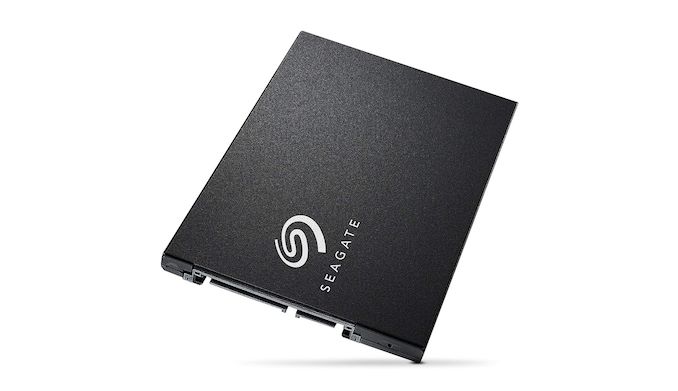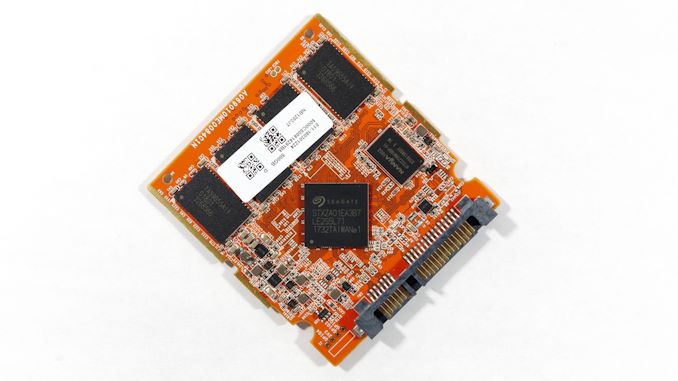The Seagate BarraCuda (500GB) SSD Review: Getting Back In The Game
by Billy Tallis on December 7, 2018 8:00 AM EST
Earlier this year, Seagate re-entered the consumer SSD market with their BarraCuda SATA SSD. It's been over five years since we last reviewed a Seagate consumer SSD, so for all practical purposes this is a fresh start for the company.
Seagate has been one of the top names in the storage industry for decades, but it's almost exclusively for their hard drives. The company has been largely absent from the consumer SSD market, and their enterprise SSDs have never particularly stood out above the competition. By comparison, rival Western Digital managed to acquire SanDisk and with it a 50% stake in one of the largest NAND flash manufacturers. Seagate's acquisitions have been less fruitful: they bought controller designer SandForce right around when SandForce drives disappeared from the market for good. Since then, Seagate has had to buy controllers and NAND on the open market and provide product differentiation through firmware or by integrating their drives into storage appliances.
The Seagate BarraCuda is not a revolutionary new SSD. It doesn't mark the release of a new SandForce controller but instead uses the very familiar and rather old Phison S10 controller. The flash is Toshiba's 64-layer 3D TLC NAND. Toshiba for their past has technically already started shipping their 96-layer TLC, but most of their production is still 64L and the 96L NAND hasn't made it into any retail SSDs yet, so the BarraCuda is up to date on the NAND choice.
This is the first drive we've tested that pairs the Phison S10 controller with 3D NAND. We first reviewed this controller in 2014, so it has had an incredibly long lifespan for such a product. With the SATA interface no longer getting speed increases, the Phison S10 isn't as obviously outclassed as such an old controller would otherwise be. It's showing its age a bit with the lack of LDPC error correction or (LP)DDR4 support, but it has proven to be an adaptable chip, supporting several generations of planar NAND and staying relevant today with support for 3D NAND. It also supports SSD capacities of up to 2TB, which was extremely implausible for a consumer drive with the flash prices in 2014, but which are now available for less than $300.
| Seagate BarraCuda SSD Specifications | ||||||
| Capacity | 250 GB | 500 GB | 1 TB | 2 TB | ||
| Form Factor | 2.5" 7mm SATA | |||||
| Controller | Seagate-branded Phison S10 | |||||
| NAND Flash | Toshiba 64L 3D TLC | |||||
| DRAM | Nanya DDR3-1600 CL11, 1.35V | |||||
| Sequential Read | 560 MB/s | |||||
| Sequential Write | 530 MB/s | 535 MB/s | 540 MB/s | 540 MB/s | ||
| Random Read | 90k IOPS | |||||
| Random Write | 90k IOPS | |||||
| Power | Active | 2.6 W | 2.6 W | 2.8 W | 3.1 W | |
| Idle | 185 mW | 192 mW | 221 mW | 225 mW | ||
| DevSleep | 5 mW | |||||
| Warranty | 5 years | |||||
| Write Endurance | 120 TB 0.26 DWPD |
249 TB 0.27 DWPD |
485 TB 0.27 DWPD |
1067 TB 0.29 DWPD |
||
| Current Retail Price | $52.99 (21¢/GB) | $84.99 (17¢/GB) | $149.99 (15¢/GB) | $349.99 (17¢/GB) | ||
The specifications for the Seagate BarraCuda look about the same as any other mainstream SATA SSD these days: TLC NAND, sequential I/O performance that mostly saturates the SATA link, and random I/O performance at up to 90k IOPS. But real-world performance depends more on performance at low queue depths and on mixed workloads, not peak numbers at QD32. This is where newer SSD controllers may have an edge over the Phison S10.
The BarraCuda is rated for a little under 0.3 drive writes per day over the duration of its 5-year warranty. We can be pretty sure that the controller can keep going that long because our earliest Phison S10 drives closing in on that age without problems. However, without the benefit of LDPC error correction, Seagate's write endurance rating isn't as conservative as the 0.3 DWPD we see on its competition.
The Seagate BarraCuda actually uses a controller chip bearing Seagate's logo and part number, but we've seen this same basic board layout many times and in many colors. Seagate is hardly the only company that rebrands off the shelf controllers. The Phison S10 is an 8-channel controller so we get 8 NAND packages, with two 256Gb dies in each package. The metal case for the drive is the same that we're used to seeing on Phison S10 drives, but with yet another variation on the paint job.
The main competitors for the Seagate BarraCuda are mainstream SATA drives like the Crucial MX500, Samsung 860 EVO, Intel 545s, and WD Blue/SanDisk Ultra 3D. These all feature 64-layer 3D NAND but more recent SSD controllers. For this review we've also included a pair of current-generation DRAMless SATA SSDs: the Mushkin Source and the Toshiba TR200, the latter of which uses the same NAND as the BarraCuda but Phison's S11 4-channel entry-level SATA SSD controller. We've also thrown in results for some older drives that used the Phison S10 controller with planar NAND: the Toshiba OCZ Trion 150 with 15nm TLC, and the PNY CS2211 with 15nm MLC.
Perhaps the most interesting point of comparison is the Plextor M8V, a drive that's generally hard to find for sale, but is very useful here because it uses the same Toshiba 3D TLC NAND but pairs it with the Silicon Motion SM2258 controller instead of the Phison S10. This helps identify which performance differences are due to the choice of NAND and which are controller or firmware bottlenecks.
| AnandTech 2018 Consumer SSD Testbed | |
| CPU | Intel Xeon E3 1240 v5 |
| Motherboard | ASRock Fatal1ty E3V5 Performance Gaming/OC |
| Chipset | Intel C232 |
| Memory | 4x 8GB G.SKILL Ripjaws DDR4-2400 CL15 |
| Graphics | AMD Radeon HD 5450, 1920x1200@60Hz |
| Software | Windows 10 x64, version 1709 |
| Linux kernel version 4.14, fio version 3.6 | |
| Spectre/Meltdown microcode and OS patches current as of May 2018 | |
- Thanks to Intel for the Xeon E3 1240 v5 CPU
- Thanks to ASRock for the E3V5 Performance Gaming/OC
- Thanks to G.SKILL for the Ripjaws DDR4-2400 RAM
- Thanks to Corsair for the RM750 power supply, Carbide 200R case, and Hydro H60 CPU cooler
- Thanks to Quarch for the XLC Programmable Power Module and accessories
- Thanks to StarTech for providing a RK2236BKF 22U rack cabinet.















39 Comments
View All Comments
takeshi7 - Friday, December 7, 2018 - link
"they bought controller designer SandForce right around when SandForce drives disappeared from the market for good."That's not strictly true. Seagate still use controllers based on SandForce for some of their enterprise SSDs. Look for DuraWrite Technology in their marketing materials to know which ones.
The_Assimilator - Friday, December 7, 2018 - link
SandForce disappeared from the *consumer* market, to be precise. And it was all the more surprising because of how much they shaped the formative years of mainstream SSDs. Reading about the reasons behind that company's implosion in someone's autobiography is going to be interesting.mikato - Friday, December 7, 2018 - link
I would like to know this also. Did the top brains get hired away to somewhere else somehow right when Seagate bought them or what?DanNeely - Friday, December 7, 2018 - link
IIRC Rumor mill at the time was that their next gen controller wasn't competitive and unable to get the design wins they needed they ran out of money and got snapped up on the cheap.Qasar - Friday, December 7, 2018 - link
https://en.wikipedia.org/wiki/SandForceBeaver M. - Wednesday, December 12, 2018 - link
Nothing was surprising. Every expert knew they wouldnt last long with their focus on compressed performance and manufacturers promoting that without criticism.Many customers felt scammed when the controllers never delivered the performance they promised, because the real high numbers were only achievable with compressible content (who the hell has a 5 GB doc file?).
In every forum experts told people not to buy Sandforce SSDs or memory sticks, because of that fact. That sealed their fate.
HighTech4US - Friday, December 7, 2018 - link
Not competitive on price.$84.99 for the 500GB model.
I just purchased on Dec 4th a brand new Intel 545s 2.5" 512GB SATA III 64-Layer 3D NAND Internal Solid State Drive SSD from Newegg for $34.99 (after $20 PayPal coupon)
Death666Angel - Friday, December 7, 2018 - link
"after $20 PayPal coupon" So, Christmas offerings plus another coupon? Great comparison!HighTech4US - Monday, December 10, 2018 - link
So show me where I can get the this 500GB model for $54..99 then. That was what I paid pre-coupon for the 512GB Intel SSD.Like I said Seagate is not competitive on price.
Donkey2008 - Thursday, December 13, 2018 - link
I used a $50 Amazon gift certificate to get my Samsung SSD for $4.99. Seagate will never beat that price.(sarcasm)